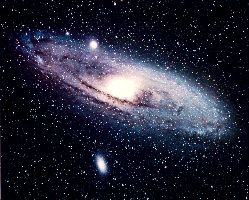A Bao A QuTo see the most lovely landscape in the world, a traveler must climb the Tower of Victory in Chitor
[Green says he found on a map of India a town named Chitor.]
A winding staircase gives access to the circular terrace on top, but only those
who do not believe in the legend dare climb the tower.
On the stairway there has lived since the beginning of time a being sensitive to the many shades
of the human soul known as A Bao A Qu. It sleeps until the approach of a traveler and
some secret life within it begins to glow and its translucent body begins to stir.
As the traveler climbs the stairs, the being regains consciousness and follows at the traveler's heels, becoming more intense in bluish color and coming closer to perfection. But it achieves its
ultimate form only at the topmost step, and only when the traveler is one
who has already attained Nirvana, whose acts cast no shadows.
Otherwise, the being hesitates at the final step and suffers at its inability to achieve perfection
["Its moan is a barely audible sound, something like the rustling of silk."]
It tumbles to the first step as the traveler climbs down and collapses weary and shapeless,
awaiting the approach of the next traveler.
In the course of the centuries, A Bao A Qu has reached the terrace only once.
spanish version:
Para contemplar el paisaje más maravilloso del mundo, hay que llegar al último piso de la Torre de Victoria, en Chitor. Hay ahí una terraza circular que permite dominar todo el horizonte. Una escalera de caracol lleva a la terraza, pero sólo se atreven a subir los no creyentes de la fábula, que dice así:
En la escalera de la Torre de la Victoria, habita desde el principio del tiempo el A Bao A Qu, sensible a los valores de las almas humanas. Vive en estado letárgico, en el primer escalón, y sólo goza de vida consciente cuando alguien sube la escalera. La vibración de la persona que se acerca le infunde vida, y una luz interior se insinúa en él. Al mismo tiempo, su cuerpo y su piel casi traslúcida empiezan a moverse. Cuando alguien asciende la escalera, El A Bao A Qu se coloca en los talones del visitante y sube prendiéndose del borde de los escalones curvos y gastados por los pies de generaciones de peregrinos. En cada escalón se intensifica su color, su forma se perfecciona y la luz que irradia es cada vez más brillante. Testimonio de su sensibilidad es el hecho de que sólo logra su forma perfecta en el último escalón, cuando el que sube es un ser evolucionado espiritualmente. De no ser así el A Bao A Qu queda como paralizado antes de llegar, su cuerpo incompleto, su color indefinido y la luz vacilante. El A Bao A Qu sufre cuando no puede formarse totalmente y su queja es un rumor apenas perceptible, semejante al roce de una seda. Pero cuando el hombre o la mujer que lo reviven están llenos de pureza, el A Bao A Qu puede llegar al último escalón, ya completamente formado e irradiando una viva luz azul. Su vuelta a la vida es muy breve, pues al bajar el peregrino, el A Bao A Qu rueda y cae hasta el escalón inicial, donde ya apagado y semejante a una lámina de contornos vagos, espera al próximo visitante. Sólo es posible verlo bien cuando llega a la mitad de la escalera, donde la prolongaciones de su cuerpo, que a manera de bracitos lo ayudan a subir, se definen con claridad. Hay quien dice que mira con todo el cuerpo y que el tacto recuerda a la piel del durazno.
En el curso de los siglos el A Bao A Qu ha llegado una sola vez a la perfección.
El capitán Burton registra la leyenda del A Bao A Qu en una de las notas de su versión de las Mil y Una Noches.
______________________________
Research:
For some reason I felt sure that C.C. Iturvuru (what an amazing name!) had heard the tale from an Orang Asli. The first person I asked happened to be Seri Pagi (though I only knew him as Pak Diap then). I gave him a simplified rendering of the A Bao A Qu legend and waited while the rusty gears of his memory whirred. His brow furrowed and then he broke into a broad grin, exclaiming in triumph: "Abang Aku! You mean Abang Aku!"
But of course. The way Orang Asli slur their vowels (especially in the states of Negri Sembilan and Pahang), Iturvuru might well have heard it as "A Bao A Qu." My Elder Brother, Abang Aku.*
I felt a jolt of electrifying knowledge. Diap said he remembered hearing a story similar to that when he was very young. It involved a spiral stairway connecting one dimension to another. A stairway once used by visiting or incarnating stargods. They say some got caught out by the calamitous closing of the interdimensional pathways. Once brilliant stars in their own universe, they fell to Earth and became ensnared in Time. Some of them ended up just like poor Abang Aku alias A Bao A Qu. A spirit fragment of cosmos caught in the gravity of human karma; a glorious starbeing lying inert at the bottom of the stairway to heaven, dependent on messy human destiny for its own fulfilment.
Only one other Elder seemed to have heard of Abang Aku. Village shaman Sudin Aus kept nodding sagely when I outlined the A Bao A Qu story to him. Then he smiled and said, “My Elder Brother is a reference to the Orang Asli. Our spirit will not be free until the younger races achieve nobility of purpose and purity of heart.”
Almost everyone, however, was familiar with the cryptic image of the long and winding stairway to the most wonderful view on Earth.

THE A BAO A QU MYTH evoked images of chakras - energy spirals operating on macro and micro levels - primordial forces attaining self-awareness, and nebulous notions of some deep alchemical mystery - an H.P. Lovecraftian vision of the strange, chthonic thoughtfields from which our familiar symbols sprout. “Abang Aku” brought to mind the Great Old Ones, ancient squid-like beings central to Lovecraft’s Chthulu tales. (It also brought to mind Gurdjieff's Kundabuffer. This peculiar word was coined in the 1920s by the Greek-Russian magician-philosopher, G.I. Gurdjieff, to explain some "tragic flaw" in Man's genetic programme which condemns him to futile lifetimes of Sisyphean* struggle, forever slipping back into robotic animality just when he's on the threshold of illumination. Some believe that this "Kundabuffer Effect" was deliberately installed by a somewhat insecure Creator God (or gods), to retard the evolution of human intelligence and thereby perpetuate a harnessable labour force on Earth. The Tower of Babel story lends credence to this notion of an "Almighty Father-God" who, feeling threatened by his mortal creatures' overweening ambitions, confounds them with a babble of tongues. Another scenario describes how humanity had its original 12-strand DNA reduced to two, to confine our consciousness within the physical world.)
I sensed that the A Bao A Qu story offered a key insight into the magical teachings of the Ancients. At some remote point in the infinite spiral of existence, an aspect of Spirit found itself trapped in a Promethean*** nightmare loop of recurring time. Only a self-realized and karma-free human could release the A Bao A Qu from its eternal yearning for perfection.
The Tower of Victory. Victory over death? Despair? Futility? The magic column of ascension, located in Chitor. Chita? Chita, cita, cinta, citta. Sanskrit for a quality difficult to define: essentially, citta means mindstuff, consciousness.
Chita or cita is closely related to cinta, romantic love - desire, emotions, feelings, longing, love, aspiration. (It could also, by invoking homophonic licence, be a slurring of cherita - nowadays spelled cerita - which means "story.") In effect one might describe chita as a poetic symbol for the Imagination, the Desiring Mind. But this is assuming it is related to Chitor, the town named in the legend of A Bao A Qu. And I assume it is, because myth is meant to be a malleable, dreamlike substance.
The test of myth-entering keys lies in their emotive resonance when struck. Substituting “Abang Aku” for “A Bao A Qu,” “Chita” and “cerita” for “Chitor,” and “you” for “the traveller” - what do we get? A metaphysical conundrum that echoes in some barely remembered attic of our unconscious. A vague feeling of déjà vu, of “When did I dream this dream?” Was I the intrepid traveller, the hero, the messiah, redeemer of gooey amorphous geeks? Or was I Abang Aku himself, waiting aeon upon aeon for humanity to attain Buddha and Christ consciousness? Who else would have “already attained Nirvana,” whose acts would “cast no shadows” - in other words, be completely free of karmic consequences. And who might this Exalted Being be - if not our own Noblest Aspect, the Omega point of our Adamic Alpha?
That's why Abang Aku reaches perfection only once. However, his dream body or holoform remains embedded in the mythic realm as a timely trigger, to awaken anyone who chances upon the legend to the nature of his or her true purpose on this Earth. ______________
* A. Ghani Ismail, an ardent scholar of Malay esoteric lore, offers some information which sheds a whole different light on the A Bao A Qu legend. He suggests that the phrase in question is actually a slurring of “Ibu Aku” (“My Mother”), explaining that in pre-Islamic Malay shamanism, the gateway to other dimensions was via an inner journey through the spiral staircase of the etheric umbilical cord which reconnects us with our pre-birth experience of oneness with the Mother. By voyaging beyond the point of our own conception, we break through the veils of time and space and regain cosmic consciousness. I thought this variation on the theme warranted inclusion, at least as a footnote.
** Sisyphean: from Sisyphus, in Greek mythology a cruel and cunning king of Corinth, who was punished in Hades by being made to roll a heavy boulder up a steep hill. Every time he got to the summit, the boulder would roll back down the hill, and Sisyphus had to repeat the process over and over forever.
*** Promethean: from Prometheus, in Greek mythology a first-generation god (or Titan) of Fire and Intellect, who returned the gift of Fire to Mankind (which Zeus the second-generation Olympian had withheld) - and for that was chained to a rock and his liver devoured by an eagle every day. Every night, the liver would regenerate and Prometheus would come back to life, only to have the eagle eat his liver all over again, and so on, ad infinitum. (It's less gory, but a lot scarier, when you approach this mythic morsel as a giant metaphor for compulsory reincarnation: Prometheus is the Soul, the rock is the physical world, the liver represents a lifetime, and the eagle is the emblem of Higher Authority or Spiritual Law. As a symbol, the eagle is interchangeable with the Indonesian garuda, the Chinese phoenix, the Mexican quetzal, or the Russian firebird, which represents Eternal Return. And Prometheus, the Fire-Bringer, is often identified with Lucifer, the Light-Bringer.) From the 'Management' point of view, Prometheus is a subversive element - but 'Labour' would see him as a cult hero, a freedom fighter, a System-bucking Little Red Robin Hood!


